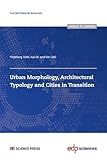Urban Morphology, Architectural Typology and Cities in Transition / Yinsheng TIAN, Wei TAO, Kai GU.
Material type: TextSeries: Current Natural SciencesPublisher: Les Ulis : EDP Sciences, [2021]Copyright date: ©2021Description: 1 online resource (210 p.)Content type:
TextSeries: Current Natural SciencesPublisher: Les Ulis : EDP Sciences, [2021]Copyright date: ©2021Description: 1 online resource (210 p.)Content type: - 9782759826742
- online - DeGruyter
| Item type | Current library | Call number | URL | Status | Notes | Barcode | |
|---|---|---|---|---|---|---|---|
 eBook
eBook
|
Biblioteca "Angelicum" Pont. Univ. S.Tommaso d'Aquino Nuvola online | online - DeGruyter (Browse shelf(Opens below)) | Online access | Not for loan (Accesso limitato) | Accesso per gli utenti autorizzati / Access for authorized users | (dgr)9782759826742 |
Frontmatter -- Contributors -- Copyright Information -- Preface -- Contents -- Chapter 1 The Structure of Urban Form: Conzenian and Caniggian Ideas -- Chapter 2 British Urban Morphology: The Conzenian Tradition -- Chapter 3 How Cities Internalize their Former Urban Fringes: A Cross-Cultural Comparison -- Chapter 4 Urban Transformation in an Inner City Area: Morphological Processes in Shieldfield,Newcastle upon Tyne, UK -- Chapter 5 Saverio Muratori and the Italian School of Planning Typology -- Chapter 6 From Muratori to Caniggia: The Origins and Development of the Italian School of Design Typology -- Chapter 7 Research on Chinese Urban Form:Retrospect and Prospect -- Chapter 8 Residential Building Types as an Evolutionary Process: The Guangzhou Area, China -- Chapter 9 Preserving the Cultural Identity of Chinese Cities in Urban Design through a Typomorphological Approach
restricted access online access with authorization star
http://purl.org/coar/access_right/c_16ec
As a body of theoretical knowledge, urban morphology in the West principally emerged within two disciplines and two parts of Europe. On the one hand there is the Anglo-German geographical school, associated with M.R.G Conzen. On the other hand there is the Italian architectural school, associated with Gianfranco Caniggia and Saverio Muratori. Based on an introduction to the theoretical tradition of the two morphological schools and their relationships, this book explores their application in empirical research and planning practice. In relation to the making of Chinese urban landscape, this book particularly focuses on the advancement of urban morphological theory and its significance for urban conservation.
Mode of access: Internet via World Wide Web.
In English.
Description based on online resource; title from PDF title page (publisher's Web site, viewed 01. Dez 2022)


